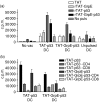Addition of TAT protein transduction domain and GrpE to human p53 provides soluble fusion proteins that can be transduced into dendritic cells and elicit p53-specific T-cell responses in HLA-A*0201 transgenic mice
- PMID: 17610503
- PMCID: PMC2266015
- DOI: 10.1111/j.1365-2567.2007.02643.x
Addition of TAT protein transduction domain and GrpE to human p53 provides soluble fusion proteins that can be transduced into dendritic cells and elicit p53-specific T-cell responses in HLA-A*0201 transgenic mice
Abstract
The protein p53 has been shown to be an efficient tumour antigen in both murine and human cancer vaccine studies and cancer vaccines targeting p53 based on major histocompatibility complex (MHC) class I binding p53-derived peptides that induce cytotoxic T lymphocytes (CTLs) without p53-specific CD4(+) T-cell help have been tested by several research groups including ours. To obtain such CD4(+) T-cell help and cover a broader repertoire of MHC haplotypes we have previously attempted to produce recombinant human p53 for vaccination purposes. However, attempts to refold a hexahis-tagged p53 protein in our laboratory were unsuccessful. Here, we show that fusion of an 11-amino-acid region of the human immunodeficiency virus TAT protein transduction domain (PTD) to human p53 increases the solubility of the otherwise insoluble p53 protein and this rTAT-p53 protein can be transduced into human monocyte-derived dendritic cells (DCs). The induction of a p53-specific HLA-A*0201 immune response was tested in HLA-A*0201/K(b) transgenic mice after immunization with rTAT-p53-transduced bone-marrow-derived DCs. In these mice, p53-specific CD4(+) and CD8(+) T-cell proliferation was observed and immunization resulted in the induction of HLA-A*0201-restricted CTLs specific for two human p53-derived HLA-A*0201-binding peptides, p53(65-73) and p53(149-157). Addition of GrpE to generate rTAT-GrpE-p53 led to a further increase in protein solubility and to a small increase in DC maturation but did not increase the observed p53-specific T-cell responses. The use of rTAT-p53 in ongoing clinical protocols should be applicable and offers advantages to current strategies omitting the use of HLA-typed patients.
Figures






Similar articles
-
Dendritic cells transduced with TAT protein transduction domain-containing tyrosinase-related protein 2 vaccinate against murine melanoma.Eur J Immunol. 2003 Apr;33(4):850-60. doi: 10.1002/eji.200323709. Eur J Immunol. 2003. PMID: 12672050
-
Tat mammaglobin fusion protein transduced dendritic cells stimulate mammaglobin-specific CD4 and CD8 T cells.Breast Cancer Res Treat. 2005 Jun;91(3):271-8. doi: 10.1007/s10549-005-0450-4. Breast Cancer Res Treat. 2005. PMID: 15952060
-
Therapy of established tumors in a novel murine model transgenic for human carcinoembryonic antigen and HLA-A2 with a combination of anti-idiotype vaccine and CTL peptides of carcinoembryonic antigen.Cancer Res. 2007 Mar 15;67(6):2881-92. doi: 10.1158/0008-5472.CAN-06-3045. Cancer Res. 2007. PMID: 17363612
-
Dendritic-Tumor Fusion Cell-Based Cancer Vaccines.Int J Mol Sci. 2016 May 26;17(6):828. doi: 10.3390/ijms17060828. Int J Mol Sci. 2016. PMID: 27240347 Free PMC article. Review.
-
Targeting p53, hdm2, and CD19: vaccination and immunologic strategies.Bone Marrow Transplant. 2000 May;25 Suppl 2:S43-5. doi: 10.1038/sj.bmt.1702353. Bone Marrow Transplant. 2000. PMID: 10933187 Review.
Cited by
-
Post-production protein stability: trouble beyond the cell factory.Microb Cell Fact. 2011 Aug 1;10:60. doi: 10.1186/1475-2859-10-60. Microb Cell Fact. 2011. PMID: 21806813 Free PMC article.
-
Mechanistic insights into the efficacy of cell penetrating peptide-based cancer vaccines.Cell Mol Life Sci. 2018 Aug;75(16):2887-2896. doi: 10.1007/s00018-018-2785-0. Epub 2018 Mar 5. Cell Mol Life Sci. 2018. PMID: 29508006 Free PMC article. Review.
-
Virus-Like Particles Derived from HIV-1 for Delivery of Nuclear Proteins: Improvement of Production and Activity by Protein Engineering.Mol Biotechnol. 2017 Jan;59(1):9-23. doi: 10.1007/s12033-016-9987-1. Mol Biotechnol. 2017. PMID: 27830536
-
Immunogenicity of a Tripartite Cell Penetrating Peptide Containing a MUC1 Variable Number of Tandem Repeat (VNTR) and A T Helper Epitope.Molecules. 2018 Sep 2;23(9):2233. doi: 10.3390/molecules23092233. Molecules. 2018. PMID: 30200528 Free PMC article.
References
-
- Guermonprez P, Valladeau J, Zitvogel L, Thery C, Amigorena S. Antigen presentation and T cell stimulation by dendritic cells. Annu Rev Immunol. 2002;20:621–67. - PubMed
-
- Figdor CGDE, Vries IJ, Lesterhuis WJ, Melief CJ. Dendritic cell immunotherapy: mapping the way. Nat Med. 2004;10:475–80. - PubMed
-
- Offringa R, Vierboom MP, van der Burg SH, Erdile L, Melief CJ. p53. a potential target antigen for immunotherapy of cancer. Ann N Y Acad Sci. 2000 June;910:223–33. - PubMed
-
- Soussi T. The p53 tumor suppressor gene: from molecular biology to clinical investigation. Ann N Y Acad Sci. 2000;910:121–37. - PubMed
Publication types
MeSH terms
Substances
LinkOut - more resources
Full Text Sources
Molecular Biology Databases
Research Materials
Miscellaneous

